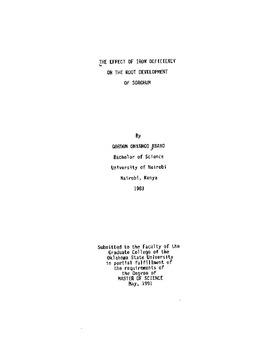| dc.description.abstract | Iron (Fe) chlorosis is a mineral deficiency disorder that is mostly associated with crops grown in arid, calcareous soils. Grain and forage sorghum types have susceptible varieties to this deficiency. The high buffer capacity, solubility, and basicity of CaC03 influence the incidence of Fe chlorosis in this and other crop plants in the Southern Great Plains and Mid-Western U.S., where 90% of sorghum production is grown in calcareous soils. In addition such soil chemical properties as Hco;, Mg, N, P, Fe, Zn, Cu, Mn and O.M. (organic matter) contents, pH, soil-water content, and compaction have been implicated as either reducing or enhancing the absorption, translocation, and/or metabolism of Fe in plants. In this study a two-year field study was conducted in 1989 and 1990 in western Oklahoma to determine: (i) effect of Fe deficiency in the number of roots, root length, and root area of grain sorghum and sudangrass, (ii) soil chemical properties that cause the deficiency and (iii) how such deficiencies affect above ground dry matter yield, nutrient content, and leaf chlorophyll content. The roots were sampled in a 100 em soil profile in both sites in 1989 and 1 site in 1990 and in a 60 em soil profile in 3 other sites in 1990. Replicated samples were collected in Fe deficient (-Fe) and Fe sufficient (+Fe) soil forms. 1 A trench-profile method was used to assess the number of roots; while a core method, hydropneumatic elutrition, and digital image analysis were used to determine the root length and area. Additional soil samples were collected in the same replications for the analyses of soil chemical properties.2 Root parameters were generally significantly greater for grain sorghum and sudangrass which were grown in the +Fe soils than in the -Fe soils (P < 0.05). Above ground dry matter yield, leaf chlorophyll content and tissue Ca, Mg, Fe, Mn, Zn, and Cu uptake were similarly significantly higher for both crops grown in +Fe soils compared to -Fe soils. The concentration of the 6 elements in the shoot tissue were,however, significantly higher in the -Fe than the +Fe soil types. The latter observation was partly attributed to ion balance, dilution effect, and probable tissue contamination by the soil aluminosilicates. The soil pH level, N03-N, P, Ca, Mg, and CaC03-equivalent contents were consistently higher in the -Fe than the +Fe soil types while soil HC03 , DTPA-extractable Fe, Mn, Zn, Cu, and OM contents were consistently higher in the +Fe than in the -Fe soil types. Iron deficiency had similar detrimental effects on the roots and shoots of grain sorghum and sudangrass in these soils. | |
